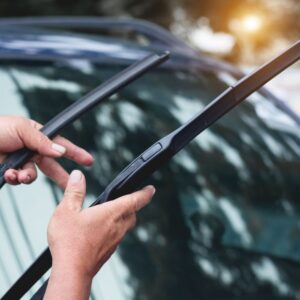You probably don’t pay much attention to your windshield spray nozzles. They’re often just neatly tucked away underneath your windshield or on top of your vehicle’s hood. But when dirt, dust, bugs, or debris accumulate on your windshield, then the windshield spray nozzles have an important role to play.
What Do Windshield Spray Nozzles Do?
When the driver pulls the windshield washer switch, the washer fluid pump will force water through the nozzles and let out a jet of windshield washer fluid towards your windshield. The fluid atomizes and sprays across the entire windshield as it passes through the small opening in the nozzle. The soapy solution loosens stubborn dirt and contaminants, allowing the wipers to sweep the dirt off. Clearing your windshield of obstructions improves the driver’s visibility, and makes driving safer.

Symptoms of Faulty Windshield Washer Nozzles
Since windshield spray nozzles are on the exterior of your vehicle, they’re exposed to dirt, grime, and dust. After some time, these elements can accumulate on the nozzle tips. It’s also exposed to wear and tear from use. A faulty windshield washer spray nozzle typically shows the following problems:
No Fluid Comes Out
If this problem persists, you can rule out a washer fluid pump problem by checking to see if this part makes noises when activated. If it makes noise, then the pump is working and the problem is caused by either a lack of fluid or a blocked windshield spray nozzle.
Fluid Doesn’t Spray Evenly
The small opening in the nozzle should atomize and spray the fluid across the entire windshield. If the nozzle isn’t spraying washer fluid in the correct volume, place, or pattern, then there might be debris in the nozzle that’s affecting it. This can either be caused by debris blocking the nozzles or damage to the nozzles themselves.
Loose Washer Nozzles
Your windshield washer nozzles’ spray can be adjusted. When washer nozzles are defective, the direction of the nozzles can be changed far too easily. This can cause your nozzles to spray in the wrong direction. The fluid can even overshoot your windshield or spray too low, preventing fluid from reaching your windshield.

How To Replace Windshield Spray Nozzles
Open your hood and find the washer hose. This is typically located directly under the hood, but some vehicles might have insulation that lines the underside of the hood. You’ll need to pull the insulation back to see the hoses attached to the hood with clips. Disconnect the washer hose from the nozzle and pry the nozzle from the outside. You might need to use a tool like a screwdriver to poke the nozzle from underneath to remove it.
Get the replacement nozzles and mount them back onto the hood from the outside. Reconnect the hoses to the nozzles and test if fluid comes out. Adjust the windshield nozzle’s direction by getting a thin rigid object like a toothpick. Gently insert this into the nozzle and adjust its direction by wiggling the toothpick.
How Much Does a Replacement Windshield Washer Nozzle Cost?
Windshield washer nozzles cost around $10 to $160. But most windshield washer nozzle kits are relatively inexpensive, ranging from $14 to $20.
Any information provided on this Website is for informational purposes only and is not intended to replace consultation with a professional mechanic. The accuracy and timeliness of the information may change from the time of publication.






























